Chapter 5: The First Night
Night falls and the invisble servants lead her to her bed, where she soon falls asleep. Then there is the rustle of wings in the darkness; Cupid is arriving (5a-b, by Klinger, who makes his Cupid somewhat older and more sophisticated).
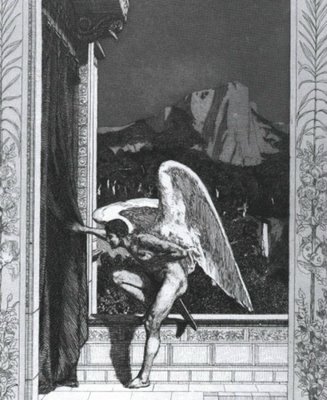
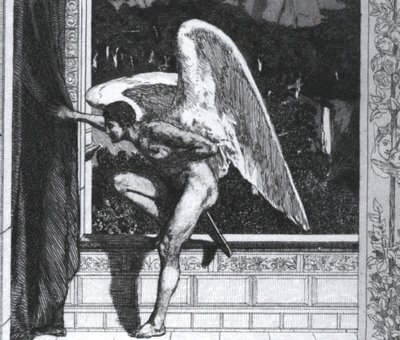
Then comes the first kiss, tender yet unseen, it is so dark (5c, Francois Gerard, 1789).

Soon they are making love (5d, a 16th century fresco in Genoa by Perin del Vaga). Her chastity is preserved, the voices assure her later, as she is his bride-—yet there have been none of the customary ceremonies.
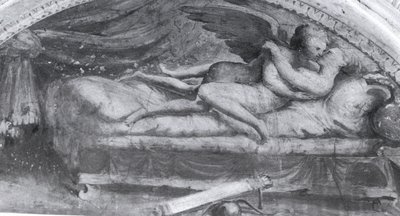
In alchemy this is known as the first coniunctio (5e, Emblem 5 of the Rosarium series).

This love, the first union of soul and spirit, innocent and passionate, is of the moment and so very unstable. In life, it often occurs in adolescence: a bliss that is momentary, and not necessarily with another person (football and ballet come to mind), and which one from then on wants to get back once it slips away.
Rodin captures the experience eloquently in his 1885 sculpture “Cupid and Psyche Embracing” (5f).
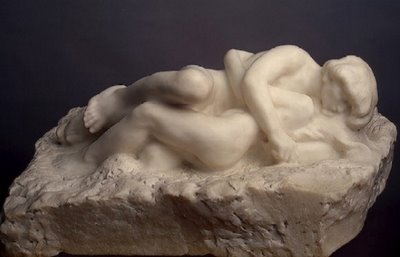
Cupid instructs her that he must never see his face. If she does, he will leave her forever, he says. Then before it gets light, he leaves. Jacques-Louis David’s 1817 painting, "Cupid leaving sleeping Psyche" (5g), gives a self-satisfied smug air to Cupid, as though he were adding a prized butterfly to his collection. This painting received a storm of protest in early 19th century France.

Picot’s version of about the same time (5h) set things right, in society's eyes, keeping the idealized image of the story.
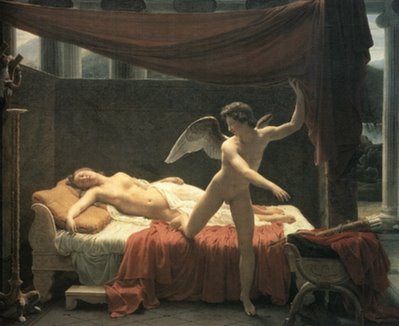
In 2005 the artist Frances Luke did a feminist take on David’s painting (5i); now it is Psyche who is alert and smug, Cupid the one lying there passively looking beautiful. (Compare the position of the arms and you will see how the work is a take-off on David).

Days and weeks go by like that. Cupid views her in the garden when she is asleep (5j, by John William Waterhouse, another pre-Raphaelite, 1903-4), in an image not in Apuleius. What is interesting here is how the artist portays the pair as virtual twins: Cupid is Psyche's divine twin.
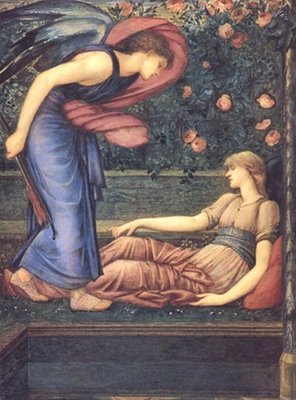
A 1949 painting by an artist named Rakopzi also portrays their similarity (5k).
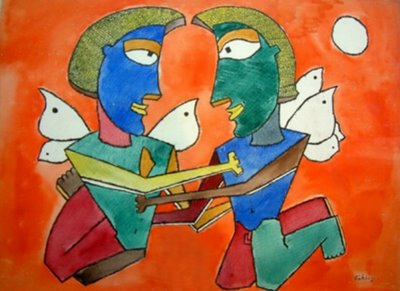
Indeed, the likeness was evident even in the first image of this presentation (1a), from ancient Rome, of the two parallel winged figures kissing.
And every night the pair makes passionate love (5l, by Wendy W. Lee, 1997):



Then comes the first kiss, tender yet unseen, it is so dark (5c, Francois Gerard, 1789).

Soon they are making love (5d, a 16th century fresco in Genoa by Perin del Vaga). Her chastity is preserved, the voices assure her later, as she is his bride-—yet there have been none of the customary ceremonies.

In alchemy this is known as the first coniunctio (5e, Emblem 5 of the Rosarium series).

This love, the first union of soul and spirit, innocent and passionate, is of the moment and so very unstable. In life, it often occurs in adolescence: a bliss that is momentary, and not necessarily with another person (football and ballet come to mind), and which one from then on wants to get back once it slips away.
Rodin captures the experience eloquently in his 1885 sculpture “Cupid and Psyche Embracing” (5f).

Cupid instructs her that he must never see his face. If she does, he will leave her forever, he says. Then before it gets light, he leaves. Jacques-Louis David’s 1817 painting, "Cupid leaving sleeping Psyche" (5g), gives a self-satisfied smug air to Cupid, as though he were adding a prized butterfly to his collection. This painting received a storm of protest in early 19th century France.

Picot’s version of about the same time (5h) set things right, in society's eyes, keeping the idealized image of the story.

In 2005 the artist Frances Luke did a feminist take on David’s painting (5i); now it is Psyche who is alert and smug, Cupid the one lying there passively looking beautiful. (Compare the position of the arms and you will see how the work is a take-off on David).

Days and weeks go by like that. Cupid views her in the garden when she is asleep (5j, by John William Waterhouse, another pre-Raphaelite, 1903-4), in an image not in Apuleius. What is interesting here is how the artist portays the pair as virtual twins: Cupid is Psyche's divine twin.

A 1949 painting by an artist named Rakopzi also portrays their similarity (5k).

Indeed, the likeness was evident even in the first image of this presentation (1a), from ancient Rome, of the two parallel winged figures kissing.
And every night the pair makes passionate love (5l, by Wendy W. Lee, 1997):


0 Comments:
Post a Comment
<< Home